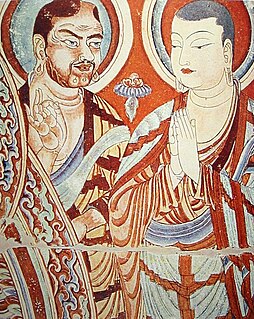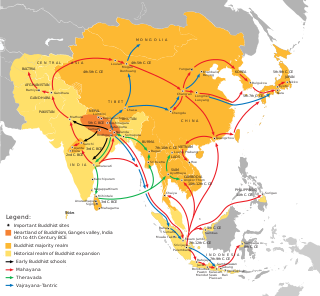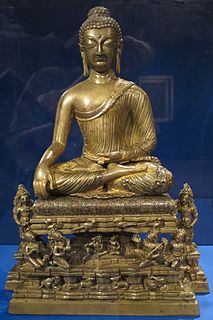Related Research Articles

Ashoka, also known as Ashoka the Great, Piodasses in ancient Greece, was an Indian emperor of the Maurya Dynasty, who ruled almost all of the Indian subcontinent from c. 268 to 232 BCE. A grandson of the Maurya dynasty's founder Chandragupta Maurya, Ashoka promoted the spread of Buddhism across ancient Asia. Considered by many to be one of India's greatest emperors, Ashoka expanded Chandragupta's empire to reign over a realm stretching from present-day Afghanistan in the west to Bangladesh in the east. It covered the entire Indian subcontinent except for parts of present-day Tamil Nadu, Karnataka, and Kerala. The empire's capital was Pataliputra, with provincial capitals at Taxila and Ujjain.

The Sarvāstivāda was one of the early Buddhist schools established around the reign of Asoka. It was particularly known as an Abhidharma tradition, with a unique set of seven Abhidharma works.

Xuanzang, born Chen Hui / Chen Yi, was a 7th-century Chinese Buddhist monk, scholar, traveler, and translator. He is known for the epoch-making contributions to Chinese Buddhism, the travelogue of his journey to India in 629–645 CE, his efforts to bring over 657 Indian texts to China, and his translations of some of these texts.

Sarnath is a place located 10 kilometres north-east of Varanasi near the confluence of the Ganges and the Varuna rivers in Uttar Pradesh, India. The Deer Park in Sarnath is where Gautama Buddha first taught the Dharma, and where the Buddhist Sangha came into existence through the enlightenment of Kondanna.

Gandhāra is the name of an ancient region located in present-day north-west Pakistan and parts of north-east Afghanistan. Gandhara was one of 16 Mahajanapada of ancient Indian subcontinent. The region centered around the Peshawar Valley and Swat river valley, though the cultural influence of "Greater Gandhara" extended across the Indus river to the Taxila region in Potohar Plateau and westwards into the Kabul Valley in Afghanistan, and northwards up to the Karakoram range.

Greco-Buddhism, or Graeco-Buddhism, is the cultural syncretism between Hellenistic culture and Buddhism, which developed between the fourth century BCE and the fifth century CE in Bactria and the Gandhara. It was a cultural consequence of a long chain of interactions begun by Greek forays into India from the time of Alexander the Great. The Macedonian satraps were then conquered by the Mauryan Empire, under the reign of Chandragupta Maurya. The Mauryan Emperor Ashoka would convert to Buddhism and spread the religious philosophy throughout his domain, as recorded in the Edicts of Ashoka.
Vibhajyavāda is a term applied generally to groups of early Buddhists belonging to the Sthavira Nikaya. These various groups are known to have rejected Sarvāstivāda doctrines and the doctrine of Pudgalavada (personalism). During the reign of Ashoka, these groups possibly took part in missionary activity in Gandhara, Bactria, Kashmir, South India and Sri Lanka. By the third century CE, they had spread in Central Asia and South-East Asia. Their doctrine is expounded in the Kathavatthu.
The history of Buddhism spans from the 6th century BCE to the present. Buddhism arose in Ancient India, in and around the ancient Kingdom of Magadha, and is based on the teachings of the Indian ascetic Siddhārtha Gautama. The religion evolved as it spread from the northeastern region of the Indian subcontinent throughout Central, East, and Southeast Asia. At one time or another, it influenced most of Asia.

The role of Greek Buddhist monks in the development of the Buddhist faith under the patronage of Emperor Ashoka around 260 BCE and subsequently during the reign of the Indo-Greek king Menander is described in the Mahavamsa, an important non-canonical Theravada Buddhist historical text compiled in Sri Lanka in the 6th century in the Pali language.

The Dharmaguptaka are one of the eighteen or twenty early Buddhist schools, depending on the source. They are said to have originated from another sect, the Mahīśāsakas. The Dharmaguptakas had a prominent role in early Central Asian and Chinese Buddhism, and their Prātimokṣa are still in effect in East Asian countries to this day, including China, Vietnam, Korea, and Japan. They are one of three surviving Vinaya lineages, along with that of the Theravāda and the Mūlasarvāstivāda.
Buddhism, which originated in India, gradually dwindled and was replaced by approximately the 12th century. According to Lars Fogelin, this was "not a singular event, with a singular cause; it was a centuries-long process."

Buddhism entered Han China via the Silk Road, beginning in the 1st or 2nd century CE. The first documented translation efforts by Buddhist monks in China were in the 2nd century CE via the Kushan Empire into the Chinese territory bordering the Tarim Basin under Kanishka. These contacts transmitted strands of Sarvastivadan and Tamrashatiya Buddhism throughout the Eastern world.

The Mahājanapadas were sixteen kingdoms or oligarchic republics that existed in Northern ancient India from the sixth to fourth centuries BCE during the second urbanisation period.

Buddhism was an important part of the classical Kashmiri culture, as is reflected in the Nilamata Purana and Kalhana's Rajatarangini. Buddhism is generally believed to have become dominant in Kashmir in the time of Emperor Ashoka, although it was widespread there long before his time, enjoying the patronage not only of Buddhist rulers but of Hindu rulers too. From Kashmir, it spread to the neighbouring Ladakh, Tibet and China. Accounts of patronage of Buddhism by the rulers of Kashmir are found in the Rajatarangini and also in the accounts of three Chinese visitors to Kashmir during 630-760 AD.

Mahīśāsaka is one of the early Buddhist schools according to some records. Its origins may go back to the dispute in the Second Buddhist council. The Dharmaguptaka sect is thought to have branched out from Mahīśāsaka sect toward the end of the 2nd or the beginning of the 1st century BCE.

Mihirakula, sometimes referred to as Mihiragula or Mahiragula, was the second and last Alchon Hun king of northwestern region of the Indian subcontinent between 502–530 CE. He was a son of and successor to Toramana of Huna heritage. His father ruled the Indian part of the Hephthalite Empire. Mihirakula ruled from his capital of Sagala.

Buddhism is an ancient Indian religion, which arose in and around the ancient Kingdom of Magadha, and is based on the teachings of the Gautama Buddha who was deemed a "Buddha", although Buddhist doctrine holds that there were other Buddhas before him. Buddhism spread outside of Magadha starting in the Buddha's lifetime.

Buddhism in Pakistan took root some 2,300 years ago under the Mauryan king Ashoka. Buddhism was the religion of predominantly Buddhist empires such as the Indo-Greek Kingdom, the Kushan Empire, and the Maurya Empire of Ashoka which ruled over what is now Pakistan.

The Alchon Huns, also known as the Alchono, Alxon, Alkhon, Alkhan, Alakhana and Walxon, were a nomadic people who established states in Central Asia and South Asia during the 4th and 6th centuries CE. They were first mentioned as being located in Paropamisus, and later expanded south-east, into the Punjab and central India, as far as Eran and Kausambi. The Alchon invasion of the Indian subcontinent eradicated the Kidarite Huns who had preceded them by about a century, and contributed to the fall of the Gupta Empire, in a sense bringing an end to Classical India.

Gandhāran Buddhism refers to the Buddhist culture of ancient Gandhāra which was a major center of Buddhism in the Indian subcontinent from the 3rd century BCE to approximately 1200 CE. Ancient Gandhāra corresponds to modern day north Pakistan, mainly the Peshawar valley and Potohar plateau as well as Afghanistan's Jalalabad. The region has yielded the Gandhāran Buddhist texts written in Gāndhārī Prakrit the oldest Buddhist manuscripts yet discovered. Gandhāra was also home to a unique Buddhist artistic and architectural culture which blended elements from Indian, Hellenistic, Roman and Parthian art. Buddhist Gandhāra was also influential as the gateway through which Buddhism spread to Central Asia and China.
References
- 1 2 Willemen, C (2013). "XUANZANG ABOUT AVALOKITEŚVARA, JIBIN, AND MADHYĀNTIKA". Annals of the Bhandarkar Oriental Research Institute. 94: 111–123. JSTOR 26493958.
- ↑ Kumāra, Braja Bihārī (2007). India and Central Asia: Classical to Contemporary Periods. Concept Publishing Company. p. 66. ISBN 978-81-8069-457-8.
- ↑ Hirakawa, Akira (1993). A History of Indian Buddhism: From Śākyamuni to Early Mahāyāna. Motilal Banarsidass Publ. p. 87. ISBN 978-81-208-0955-0.
- ↑ Warikoo, Kulbhushan (2009). Cultural Heritage of Jammu and Kashmir. Pentagon Press. ISBN 978-81-8274-376-2.
- ↑ Bibhuti Baruah (2000). Buddhist Sects and Sectarianism. Sarup & Sons. p. 453. ISBN 978-81-7625-152-5.